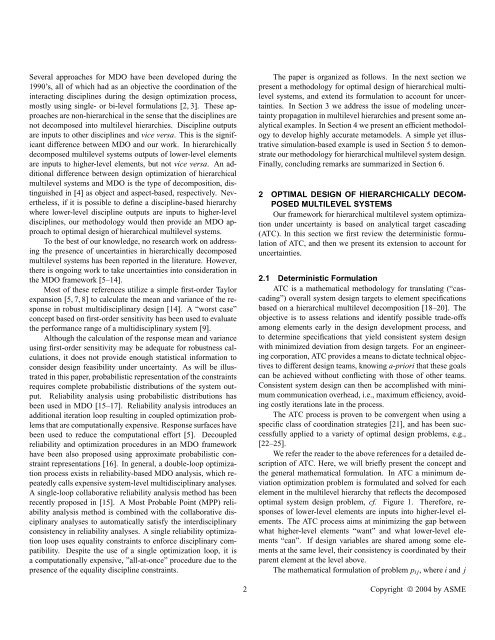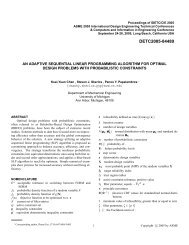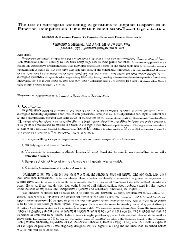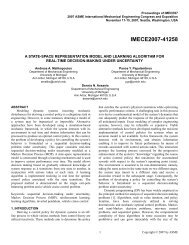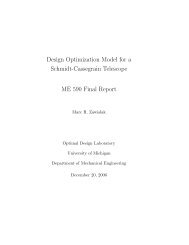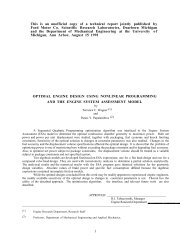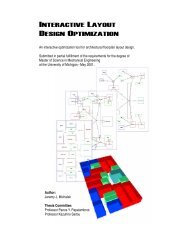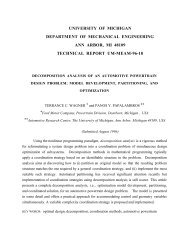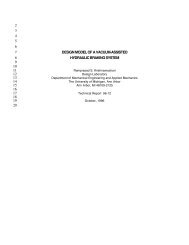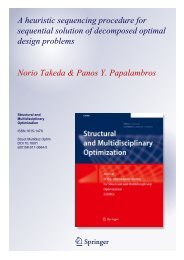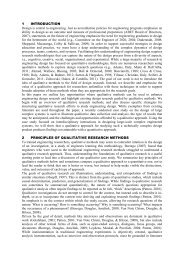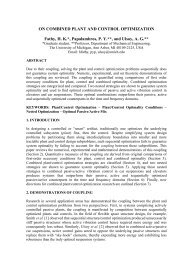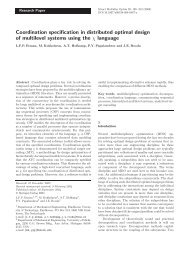Design Optimization of Hierarchically Decomposed Multilevel ...
Design Optimization of Hierarchically Decomposed Multilevel ...
Design Optimization of Hierarchically Decomposed Multilevel ...
You also want an ePaper? Increase the reach of your titles
YUMPU automatically turns print PDFs into web optimized ePapers that Google loves.
Several approaches for MDO have been developed during the<br />
1990’s, all <strong>of</strong> which had as an objective the coordination <strong>of</strong> the<br />
interacting disciplines during the design optimization process,<br />
mostly using single- or bi-level formulations [2, 3]. These approaches<br />
are non-hierarchical in the sense that the disciplines are<br />
not decomposed into multilevel hierarchies. Discipline outputs<br />
are inputs to other disciplines and vice versa. This is the significant<br />
difference between MDO and our work. In hierarchically<br />
decomposed multilevel systems outputs <strong>of</strong> lower-level elements<br />
are inputs to higher-level elements, but not vice versa. An additional<br />
difference between design optimization <strong>of</strong> hierarchical<br />
multilevel systems and MDO is the type <strong>of</strong> decomposition, distinguished<br />
in [4] as object and aspect-based, respectively. Nevertheless,<br />
if it is possible to define a discipline-based hierarchy<br />
where lower-level discipline outputs are inputs to higher-level<br />
disciplines, our methodology would then provide an MDO approach<br />
to optimal design <strong>of</strong> hierarchical multilevel systems.<br />
To the best <strong>of</strong> our knowledge, no research work on addressing<br />
the presence <strong>of</strong> uncertainties in hierarchically decomposed<br />
multilevel systems has been reported in the literature. However,<br />
there is ongoing work to take uncertainties into consideration in<br />
the MDO framework [5–14].<br />
Most <strong>of</strong> these references utilize a simple first-order Taylor<br />
expansion [5, 7, 8] to calculate the mean and variance <strong>of</strong> the response<br />
in robust multidisciplinary design [14]. A “worst case”<br />
concept based on first-order sensitivity has been used to evaluate<br />
the performance range <strong>of</strong> a multidisciplinary system [9].<br />
Although the calculation <strong>of</strong> the response mean and variance<br />
using first-order sensitivity may be adequate for robustness calculations,<br />
it does not provide enough statistical information to<br />
consider design feasibility under uncertainty. As will be illustrated<br />
in this paper, probabilistic representation <strong>of</strong> the constraints<br />
requires complete probabilistic distributions <strong>of</strong> the system output.<br />
Reliability analysis using probabilistic distributions has<br />
been used in MDO [15–17]. Reliability analysis introduces an<br />
additional iteration loop resulting in coupled optimization problems<br />
that are computationally expensive. Response surfaces have<br />
been used to reduce the computational effort [5]. Decoupled<br />
reliability and optimization procedures in an MDO framework<br />
have been also proposed using approximate probabilistic constraint<br />
representations [16]. In general, a double-loop optimization<br />
process exists in reliability-based MDO analysis, which repeatedly<br />
calls expensive system-level multidisciplinary analyses.<br />
A single-loop collaborative reliability analysis method has been<br />
recently proposed in [15]. A Most Probable Point (MPP) reliability<br />
analysis method is combined with the collaborative disciplinary<br />
analyses to automatically satisfy the interdisciplinary<br />
consistency in reliability analyses. A single reliability optimization<br />
loop uses equality constraints to enforce disciplinary compatibility.<br />
Despite the use <strong>of</strong> a single optimization loop, it is<br />
a computationally expensive, ”all-at-once” procedure due to the<br />
presence <strong>of</strong> the equality discipline constraints.<br />
The paper is organized as follows. In the next section we<br />
present a methodology for optimal design <strong>of</strong> hierarchical multilevel<br />
systems, and extend its formulation to account for uncertainties.<br />
In Section 3 we address the issue <strong>of</strong> modeling uncertainty<br />
propagation in multilevel hierarchies and present some analytical<br />
examples. In Section 4 we present an efficient methodology<br />
to develop highly accurate metamodels. A simple yet illustrative<br />
simulation-based example is used in Section 5 to demonstrate<br />
our methodology for hierarchical multilevel system design.<br />
Finally, concluding remarks are summarized in Section 6.<br />
2 OPTIMAL DESIGN OF HIERARCHICALLY DECOM-<br />
POSED MULTILEVEL SYSTEMS<br />
Our framework for hierarchical multilevel system optimization<br />
under uncertainty is based on analytical target cascading<br />
(ATC). In this section we first review the deterministic formulation<br />
<strong>of</strong> ATC, and then we present its extension to account for<br />
uncertainties.<br />
2.1 Deterministic Formulation<br />
ATC is a mathematical methodology for translating (“cascading”)<br />
overall system design targets to element specifications<br />
based on a hierarchical multilevel decomposition [18–20]. The<br />
objective is to assess relations and identify possible trade-<strong>of</strong>fs<br />
among elements early in the design development process, and<br />
to determine specifications that yield consistent system design<br />
with minimized deviation from design targets. For an engineering<br />
corporation, ATC provides a means to dictate technical objectives<br />
to different design teams, knowing a-priori that these goals<br />
can be achieved without conflicting with those <strong>of</strong> other teams.<br />
Consistent system design can then be accomplished with minimum<br />
communication overhead, i.e., maximum efficiency, avoiding<br />
costly iterations late in the process.<br />
The ATC process is proven to be convergent when using a<br />
specific class <strong>of</strong> coordination strategies [21], and has been successfully<br />
applied to a variety <strong>of</strong> optimal design problems, e.g.,<br />
[22–25].<br />
We refer the reader to the above references for a detailed description<br />
<strong>of</strong> ATC. Here, we will briefly present the concept and<br />
the general mathematical formulation. In ATC a minimum deviation<br />
optimization problem is formulated and solved for each<br />
element in the multilevel hierarchy that reflects the decomposed<br />
optimal system design problem, cf. Figure 1. Therefore, responses<br />
<strong>of</strong> lower-level elements are inputs into higher-level elements.<br />
The ATC process aims at minimizing the gap between<br />
what higher-level elements “want” and what lower-level elements<br />
“can”. If design variables are shared among some elements<br />
at the same level, their consistency is coordinated by their<br />
parent element at the level above.<br />
The mathematical formulation <strong>of</strong> problem p i j , where i and j<br />
2 Copyright © 2004 by ASME


